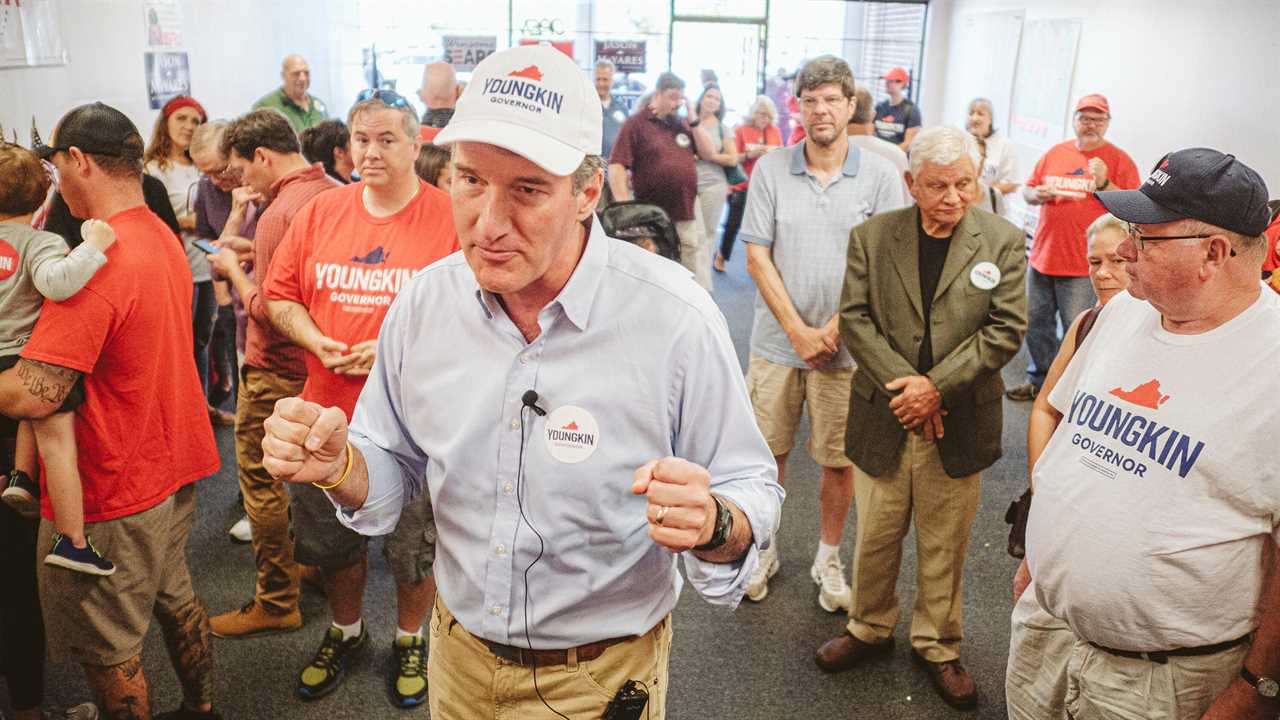
With the much-watched election for Virginia governor 12 days away, Glenn Youngkin, the Republican nominee, has been getting the word out: Vote early.
His campaign texts supporters asking if they know their early voting site, and door knockers ask if voters have requested a mail-in ballot. Youngkin holds rallies near early polling locations, including a recent one in Rockingham County after which the campaign said 100 people walked in to vote.
“We’ve been encouraging all Virginians to come vote, vote early,” Youngkin said when he cast his own ballot weeks before Election Day on Nov. 2.
There is no small irony in that message. Former President Donald J. Trump has loudly, falsely and egregiously claimed that early voting, especially by mail, led to a “rigged” election in 2020 that cost him a second term. (His latest provocation was a statement on Thursday: “The insurrection took place on November 3, Election Day. Jan 6 was the protest!”)
In response to baseless claims of fraud, Republican-led states around the country have enacted laws this year to narrow access to the polls by groups that tend to vote for Democrats.
Virginia, where Democrats are in charge, has gone the opposite way, expanding voting access, including establishing a 45-day window to vote early in person or by mail, and extending the hours and locations of early polling sites.
Youngkin, a former financial executive who reminds many of an even-tempered Mitt Romney more than the bullying Trump, has still catered to the Trump base that believes the former president’s election conspiracy theories.
Youngkin early on said his top issue was “election integrity,” code for the false view that the 2020 vote was stolen, and he offered supporters a “membership card” in his Election Integrity Task Force. He campaigned with State Senator Amanda Chase, a prolific spreader of conspiracy theories about Jan. 6. This month he said voting machines should be audited, even though Virginia’s Elections Department audited machines after the 2020 vote and confirmed the results. (Trump lost by 10 points.)
Still, Youngkin has invested heavily in turning out his supporters early, a strategy at which Republicans once excelled in many places. An early vote, cast in person or by mail, means a campaign doesn’t have to pursue that voter with phone calls and door knocks in the final frenzied weeks.
Kristin Davison, a senior strategist for the Youngkin campaign, rejected the notion that Youngkin was sending supporters mixed messages about early voting through his emphasis on election security.
“Glenn has been consistent the entire way through that the best way to ensure a safe and fair election is to go and be a voter,” Davison said.
As of Wednesday, 515,000 Virginians had voted early, according to the Virginia Public Access Project, drawing on state Elections Department data.
Virginia voters don’t register by party, but the Democratic data firm TargetSmart, using demographic information, has modeled the early voters. It estimates that 55.4 percent of early ballots have been cast by Democrats, 30.1 percent by Republicans and 14.4 percent by independents.
The overall early voting total is 31 percent of early votes cast in the same period in 2020. Even though off-year turnout is bound to drop off from a presidential year, the Youngkin campaign maintained that it was an ominous sign for Terry McAuliffe, the Democratic nominee, showing low enthusiasm from his supporters.
“Republicans typically don’t win the early vote,” Davison said. “If Terry were in place to win, turnout would be at least 10 points higher.”
McAuliffe’s campaign dismissed that analysis. It argued that there were important differences between early voting this year and last year, when the pandemic drove up the use of mail ballots. Last year was the first time Virginia offered no-excuse absentee voting; in 2021, the McAuliffe campaign said, Virginia voters are returning to what they are used to, namely Election Day voting.
“The comparison to 2020 isn’t really a good one,” said Simon Vance, a data adviser to McAuliffe. “What you’re seeing is not any drop-off, but people reverting back to behaviors they’ve done for years.”
The McAuliffe campaign pointed to the large number of mail ballots that have been requested but not yet returned — around 175,000. “We know those are our people and we’re aggressively chasing them,” Vance said.
To boost his get-out-the-vote effort, McAuliffe is welcoming top Democrats, including former President Barack Obama and President Biden, to campaign with him in coming days. Last Sunday, Stacey Abrams, the Georgia voting rights activist, visited three churches in Norfolk, Va., and appeared with McAuliffe at a rally outside an early voting site. “We’ve got to get everybody out to vote,” McAuliffe said at the event.
Total in-person early voters in Norfolk that day was 370. The Youngkin campaign called that an anemic figure. “If Terry’s base was excited, that number should have been at least three times that,” Davison asserted.
Vance disagreed. He said that McAuliffe was on track to have the turnout needed to win.
“If we’re seeing 70, 65 percent of the total electorate voting on Election Day, that’s where the real story will be told,” he said.
nine days of ideas to remake our future






